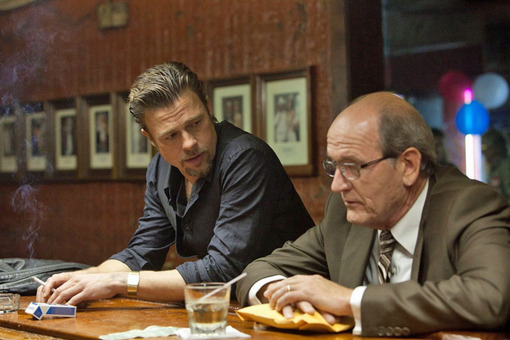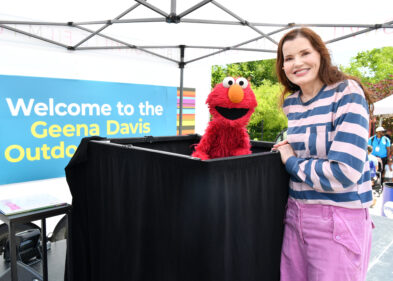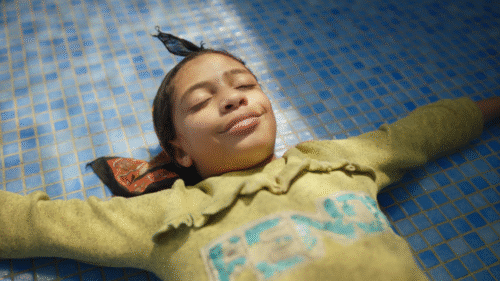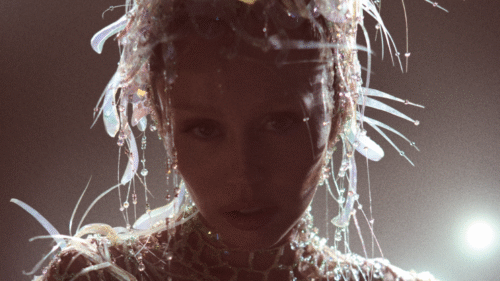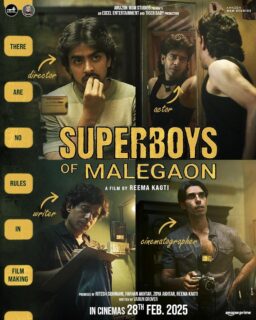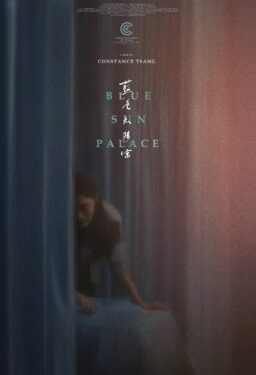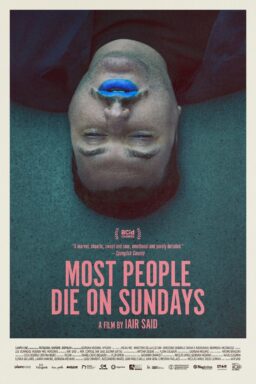Today looks to be a day of renegades and gangsters from the start, with “Killing Them Softly” by Andrew Dominik, the second American film to premier in competition, first thing in the morning. The all-male cast is headlined by Brad Pitt, who also starred in the director’s Oscar-nominated “The Assassination of Jesse James by the Coward Robert Ford. ” This is a talky tough-guy movie that is heavy on long interchanges among thugs with odd accents and/or speech impediments. Talking like a tough guy means modifying every noun with the f-word (and I wonder what the grand total would be for this film).
“Killing Them Softly” is set in New Orleans, although pains are taken to avoid any distinctly identifying landmarks. The grey, wet, boarded-up desolation of the landscape could only be the post-Katrina lower 9th Ward, and I found the film’s fleeting glimpses of that more electrifying than the introduction of Frankie (Scoot McNairy) and Russell (Ben Mendelsohn), a pair of lowlifes setting up a robbery with Squirrel (Vincent Curatola).

The two bumblers manage, just barely, to pull off the robbery of a high-stakes poker game, which makes it only a matter of time before they’re marked men. It also makes Markie (Ray Liotta), the pudgy mid-level gangster who was running the game a suspect. Whatever higher authority these thugs answer to calls in its enforcer Jackie Cogan (Brad Pitt) to sort it out.
The first and only woman, who is also the first and only black person in the story, makes her appearance one hour into the film. She’s a prostitute who’s treated like garbage in her approximately two minutes on the screen. This is not only a man’s world, it’s a white man’s world.

Incidents of insane violence punctuate the plot, which is otherwise strong on character development. Markie gets taught a lesson in a prolonged beating that is sickening in its savagery but reminiscent of “GoodFellas.” Jackie’s first hit in his cleanup operation involves a big slow-motion set piece of dreamily floating bullets and slowly shattering glass. I couldn’t help but be reminded that John Woo made his American debut shooting “Hard Target” in New Orleans in 1993, and that marked the real beginning of the Woo-influenced approach to this type of action that is now regarded as a Hollywood industry standard.
I could have done without most of the soundtrack music, which reinforced a few cliches. Like “Lawless,” “Killing Them Softly” tries to match the music to the action. For instance, when Russell is shooting up heroin the chords of “Heroin” by the Velvet Underground are heard, and the screen goes all light-show swirly. I was grateful that we were spared “Purple Haze” when he smokes a joint.

Brad Pitt’s performance is impressive in its restraint. This script doesn’t give him much of a star turn, and that’s OK. He’s truly a member of an ensemble cast, and the low-key authority of his Jackie Cogan goes a long way toward balancing the motor-mouth hysteria of other characters.

Japanese director Takashi Miike is back at Cannes with “For Love’s Sake” screening out of competition. He was in competition last year with the sluggish 3-D dud “Hara-Kiri: Death of a Samurai.” He has a cult reputation for films including “Thirteen Assassins,” “Sukiyaki Western Django” (one of Quentin Tarantino’s favorite films), and “Audition.” He’s a wild card of a director, and his films can be hit or miss.
“For Love’s Sake” is a wacko musical set in 1972 Tokyo. Miike gives the film the look of 16mm Kodachrome. There’s a golden cast to the light, the colors are saturated and sometimes neon-bright, but the image often has a graininess that would have once been associated with experimental films of the era.
There are so many outrageous musical numbers in the first half-hour of “For Love’s Sake” that you could almost classify it as a pop opera. Miike doesn’t keep up the pace, though, and, as happens in some of his other films, the novelty of the whole enterprise begins to wear thin.

The film opens with a brief anime sequence in which little Ai Saotome, daughter of a wealthy family, is saved from a skiing accident by a boy who is subsequently left with a large distinctive scar on his forehead. In that moment, Ai pledges her heart to this boy Makoto for life.
Fast forward some years to Ai as a proper young lady and Makoto as a mop-headed rebel whose sneer defines cool. In the first big musical number, kind of like “West Side Story” but with kung fu, he inadvertently saves her once again, this time from the unwanted attentions of a Hawaiian shirt-clad street gang. He rejects her attentions, but in gratitude she secretly arranges for her millionaire father to enroll him in her posh college prep school. In an effort to support him in the style to which he’s become accustomed, Ai innocently applies for a job as a waitress at Cafe Purity, which features nude floorshows.

“For Love’s Sake” is mannered and farcical, and the dialogue is all tongue-in-cheek, with lines like “What’s a barbarian like this doing at our elite school?” and “The arrogance of the rich makes me vomit.” When Ai comes home to her parents, her stuffy dad says “Let’s celebrate like true bourgeois,” and mom and dad launch into a jerky-limbed production number that’s a total hoot.
The fight scenes are played for laughs and the production numbers can be mind-bogglingly funny, but the excess becomes numbing. More characters are introduced, and there are more rivals for Makoto’s non-existent affection. The cycle of Ai’s rejection begins to repeat itself endlessly.

Since suffering declining health in 2003, director Bernardo Bertolucci has required the use of a wheelchair. “Me and You,” screening here out of competition, is his first film in ten years. In the production notes Bertolucci says, “When forced immobility became my normality, I thought my filmmaking days were over… Little by little I learned the ‘art’ of accepting my condition, and from that moment I knew that it was possible to make films from a different position than usual. Seated rather than standing.”
Before seeing “Me and You” I wondered whether Bertolucci would adopt an Ozu-like approach, filming from a fixed position and from a lower angle. In fact, it’s the opposite. The film often utilizes steep angles and swooping camera movements that start low and glide high or vice-versa. There’s mobility inherent in the image, as if the director were consciously sending the camera where his legs can’t go.
“Me and You” is the story of Lorenzo, a reclusive but precocious 14-year-old boy with the full face and generous curls of a young Maria Schneider in “Last Tango in Paris, ” but with the spooky eyes of Keir Dullea. He’s in therapy, although not making progress, and his parents worry that he refuses to interact with his peers. His greatest interest is in studying insects. His mother thinks it’s a breakthrough when he agrees to go on a class ski trip. Instead, he fits out a makeshift hideaway in the basement of their apartment building, where he intends to spend a week alone with his laptop, headphones, and ant farm.

Lorenzo’s solitude is immediately interrupted by the arrival of Olivia, a slightly older half-sister who’s all but a stranger to him. She crashes his hideaway looking for her belongings in the storage area and ends up forcing him to let her stay. She’s a few years older and beautiful, but already hardened by cynicism and heroin abuse.
It’s tempting to grasp for some parallels with “Last Tango in Paris, ” Bertolucci’s other film in a closed space, but “Me and You” doesn’t begin to approach that level of tension and soul-baring; neither does it have the eroticism. In some ways this film has the constricted feeling of a one-set play with a variety of incidents that advance the intimacy between brother and sister.

Early in “Me and You” Lorenzo shocks his mother by asking if she would have sex with him if they were the last survivors on earth and it was the only means of saving the human race. Bertolucci toys with the expectations of his viewers by dropping what appear to be intimations of where the relationship between Lorenzo and Olivia is headed. In the agony of her drug withdrawal she writhes on the floor in her sexy underwear, and touches his face with tenderness. He is protective and jealous when she invites another man to visit their lair. It’s a tease, and Bertolucci is taking this story in a less provocative direction.

“Me and You” is a film with many flaws, but we can only hope that it’s a new start for a distinguished career rather than an end point. Once again in his own words from the production notes, Bertolucci says: “Having shot ‘Me and You’ I feel I’m back on the run and I’m ready to make another film as soon as possible.”
“Holy Motors,” the return to the screen of bad boy French director Leos Carax after a long absence, premiered in competition tonight. Cannes loves a film that gets people worked up, and this one did it, ending to a roar of enthusiastic shouts, hoots, applause and boos all mixed together so that it was impossible to tell whether the shouters and hooters were for or against. This is the one that everybody’s going to be debating until the end of the festival.

Some will call “Holy Motors” a holy mess, others will call it a masterpiece. It’s very much a wild, mythic enigma, and the pieces don’t fit together with any conventional logic. A mysterious white stretch limousine travels though Paris carrying one man, and driven by Celine (Edith Scob) a blonde woman in a white suit. The traveler in the car has many lives to live and many missions to carry out. In between, he transforms himself in the back of the car with wigs and makeup as if he were an actor about to make his entrance.

The man, Mr. Oscar, is a businessman, a knife fighter who transforms his victim into a replica of himself, the father of a young girl attending her first party, a hitman, a dying uncle, a forlorn lover, and more. All are played by seasoned actor Denis Lavant, who has starred in Carax films including “Boy Meets Girl,” “Mauvais Sang,” “Lovers on the Bridge,” and the Carax sequence from the omnibus film “Tokyo!,” in which he played Merde, the twisted red-haired dwarf who emerges from a Tokyo manhole to run riot in the streets with cruel, demented pranks.

Lavant reprises the role of Merde in one of the most bizarre sequences of “Holy Motors.” He emerges from a manhole and disrupts a fashion shoot in a Paris cemetery, throwing the passive model (Eva Mendes) over his shoulder and limping through ancient tunnels to his underground cave, where the beauty and the beast appear to reach an understanding.

Halfway through this chaotic narrative Carax throws a handwritten intermission card on the screen and cuts away to one of my favorite parts of the film. A lone accordion player (also Lavant) wanders among the shadows of the stone pillars of one of Paris’s great churches. Other accordion players appear behind him, and the crowd of musicians grows larger and larger as the wheezy, haunting strains of their music reach a crescendo in the echoes of the church. It’s pure magic.

Mr. Oscar has a date with his past when his car meets up with another white stretch limousine bearing Jean (Kylie Minogue), a woman with a list of special missions of her own. The two avatars (or whatever they’re meant to be) enter the beautiful old Samaritaine department store building, now empty and gutted, to climb to the roof, where Jean has a date with destiny. She bursts into a romantic ballad on the way, and characteristic of the way Carax can shift the tone of a scene in a flash, the song ends with the sound of Mr. Oscar violently kicking the head of an abandoned mannequin into a wall.
Why the avatars perform the function they do, and to what end is a complete mystery. Much of “Holy Motors” is a complete mystery, holding the meaning of its entrancing beauty and challenging ugliness just beyond reach.


